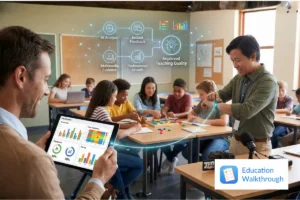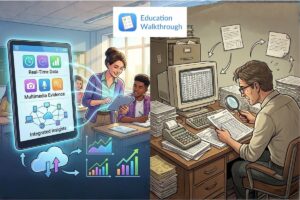Instructional coaching is a powerful tool in the world of education, designed to enhance teaching practices and, ultimately, student learning. At the heart of this approach are learning targets, clear and concise statements that outline what students should know or be able to do by the end of a lesson or unit. This article delves into the intricacies of learning targets within the context of instructional coaching, offering a comprehensive exploration of this essential educational concept.
Learning targets are more than just lesson objectives; they are the guiding stars of instructional coaching. They provide direction, foster student engagement, and serve as a measure of progress. Understanding the role and application of learning targets is crucial for any instructional coach aiming to make a significant impact on teaching and learning.
What are Learning Targets?
Learning targets are specific, measurable, and achievable goals that are set for each lesson or unit in a curriculum. They are derived from standards and are designed to guide instruction and assessment. Learning targets articulate the knowledge, skills, and dispositions students should acquire through instruction.
These targets are not just for teachers; they are shared with students to help them understand the purpose of the lesson, what they are expected to learn, and how they will demonstrate their learning. By making learning targets explicit, teachers and instructional coaches can foster a more focused and purposeful learning environment.
Characteristics of Effective Learning Targets
Effective learning targets share certain characteristics. They are specific, aligning closely with the lesson content and clearly articulating what students should know or be able to do. They are measurable, providing a clear criterion for success. They are achievable, challenging students while remaining within their zone of proximal development. And they are relevant, connecting to broader educational goals and real-world applications.
Additionally, effective learning targets are student-friendly. They are written in language that students can understand, allowing them to take ownership of their learning. They are also visible, displayed in the classroom or shared at the beginning of the lesson, so students can refer to them throughout the learning process.
Types of Learning Targets
Learning targets can be categorized into four types: knowledge targets, skill targets, reasoning targets, and product targets. Knowledge targets focus on what students should know, such as facts, concepts, or information. Skill targets emphasize what students should be able to do, such as procedures or techniques. Reasoning targets require students to use knowledge and skills to think critically or solve problems. Product targets involve creating a tangible product or performance that demonstrates learning.
These types of learning targets are not mutually exclusive; a single lesson or unit may incorporate multiple types of targets. The key is to ensure that the targets align with the lesson content and instructional strategies, providing a clear and coherent roadmap for learning.
The Role of Learning Targets in Instructional Coaching
Learning targets play a pivotal role in instructional coaching. They serve as a common language between the coach and the teacher, facilitating collaborative planning and reflection. They guide the observation and feedback process, providing a clear focus for the coach’s attention and a concrete basis for discussion. And they inform the coaching cycle, helping to identify areas of strength and areas for improvement.
Moreover, learning targets are instrumental in promoting effective teaching practices. They encourage teachers to plan with the end in mind, designing lessons that align with desired learning outcomes. They foster student-centered instruction, empowering students to take charge of their learning. And they support formative assessment, enabling teachers to monitor student progress and adjust instruction as needed.
Using Learning Targets in Coaching Conversations
Learning targets can be a powerful tool in coaching conversations. They provide a focus for discussion, allowing the coach and teacher to delve into the specifics of lesson planning, instruction, and assessment. They also provide a basis for feedback, enabling the coach to offer constructive suggestions for enhancing learning targets and aligning instruction with these targets.
When using learning targets in coaching conversations, it’s important to approach the discussion with a collaborative and reflective mindset. The goal is not to critique or judge, but to explore possibilities for enhancing teaching and learning. By focusing on learning targets, coaches can help teachers see their practice from a new perspective and discover new strategies for promoting student learning.
Integrating Learning Targets into the Coaching Cycle
The coaching cycle is a structured process for instructional coaching, typically consisting of pre-observation planning, observation, and post-observation reflection. Learning targets can be integrated into each stage of this cycle, providing a consistent focus and framework for the coaching process.
In the pre-observation stage, the coach and teacher can collaborate to develop clear and effective learning targets for the upcoming lesson. During the observation, the coach can focus on how the teacher communicates and implements these targets. And in the post-observation stage, the coach and teacher can reflect on the effectiveness of the learning targets and discuss strategies for improvement.
Benefits of Learning Targets in Instructional Coaching
Learning targets offer numerous benefits in the context of instructional coaching. They enhance the clarity and coherence of instruction, providing a clear roadmap for teaching and learning. They foster student engagement and ownership of learning, empowering students to take charge of their educational journey. And they support formative assessment and differentiated instruction, enabling teachers to meet the diverse needs of their students.
Moreover, learning targets facilitate effective coaching practices. They provide a common language for collaboration and reflection, enhancing the coach-teacher relationship. They guide the observation and feedback process, enabling coaches to offer targeted and meaningful support. And they inform the coaching cycle, helping to identify areas of strength and areas for improvement, and guiding the development of action plans for professional growth.
Enhancing Clarity and Coherence of Instruction
One of the key benefits of learning targets is their ability to enhance the clarity and coherence of instruction. By articulating the desired learning outcomes in a clear and specific manner, learning targets provide a roadmap for teaching and learning. They guide lesson planning, instruction, and assessment, ensuring that all elements of the instructional process are aligned with the intended learning outcomes.
This clarity and coherence are not just beneficial for teachers; they are also beneficial for students. When students understand the learning targets, they have a clearer sense of the purpose of the lesson and what they are expected to learn. This can enhance their engagement and motivation, and provide a sense of direction and purpose in their learning journey.
Fostering Student Engagement and Ownership of Learning
Learning targets can also foster student engagement and ownership of learning. By making the learning targets explicit and student-friendly, teachers can help students understand what they are expected to learn and how they will demonstrate their learning. This can empower students to take charge of their learning, actively engaging in the learning process and taking responsibility for their progress.
Moreover, learning targets can serve as a tool for self-assessment and self-regulation. Students can use the learning targets to monitor their understanding, identify areas of confusion, and seek help when needed. They can also use the learning targets to reflect on their learning, evaluating their progress and setting goals for future learning.
Challenges and Solutions in Implementing Learning Targets
While learning targets offer numerous benefits, implementing them effectively can pose certain challenges. These challenges may include developing clear and measurable targets, communicating the targets effectively to students, and using the targets to guide instruction and assessment. However, with thoughtful planning and ongoing support from instructional coaches, these challenges can be overcome.
Moreover, the process of implementing learning targets can provide valuable opportunities for professional growth. It can foster a deeper understanding of the curriculum and standards, enhance instructional planning and delivery skills, and promote a culture of reflection and continuous improvement. Thus, despite the challenges, the effort invested in implementing learning targets can yield significant rewards for both teachers and students.
Developing Clear and Measurable Targets
One of the challenges in implementing learning targets is developing targets that are clear, measurable, and aligned with the standards. This requires a deep understanding of the curriculum and standards, as well as the ability to articulate learning outcomes in a specific and measurable manner. It may also require a shift in mindset, from focusing on what teachers will do to focusing on what students will learn.
Instructional coaches can support teachers in this process by providing resources and guidance on developing effective learning targets. They can also facilitate collaborative planning sessions, where teachers can work together to develop and refine their learning targets. Through this collaborative process, teachers can learn from each other’s experiences and insights, enhancing their capacity to develop clear and measurable learning targets.
Communicating Targets Effectively to Students
Another challenge in implementing learning targets is communicating the targets effectively to students. This involves not just sharing the targets at the beginning of the lesson, but also ensuring that students understand the targets and can connect them to their learning. It also involves revisiting the targets throughout the lesson, helping students to stay focused and on track.
Instructional coaches can support teachers in this process by modeling effective strategies for communicating learning targets. They can also provide feedback on the teacher’s communication of targets, offering constructive suggestions for improvement. Moreover, they can facilitate professional learning communities, where teachers can share and discuss their strategies for communicating learning targets, fostering a culture of collaborative learning and continuous improvement.
Conclusion
Learning targets are a cornerstone of effective instructional coaching. They provide a clear and coherent roadmap for teaching and learning, foster student engagement and ownership of learning, and guide the coaching process. While implementing learning targets can pose certain challenges, these challenges can be overcome with thoughtful planning and ongoing support from instructional coaches. Moreover, the process of implementing learning targets can provide valuable opportunities for professional growth, enhancing the capacity of teachers to promote student learning.
As this article has demonstrated, learning targets are more than just lesson objectives; they are the guiding stars of instructional coaching. By understanding and leveraging the power of learning targets, instructional coaches can make a significant impact on teaching and learning. Whether you are a seasoned instructional coach or a teacher aspiring to enhance your practice, the exploration of learning targets in this article can provide valuable insights and strategies for your professional journey.



